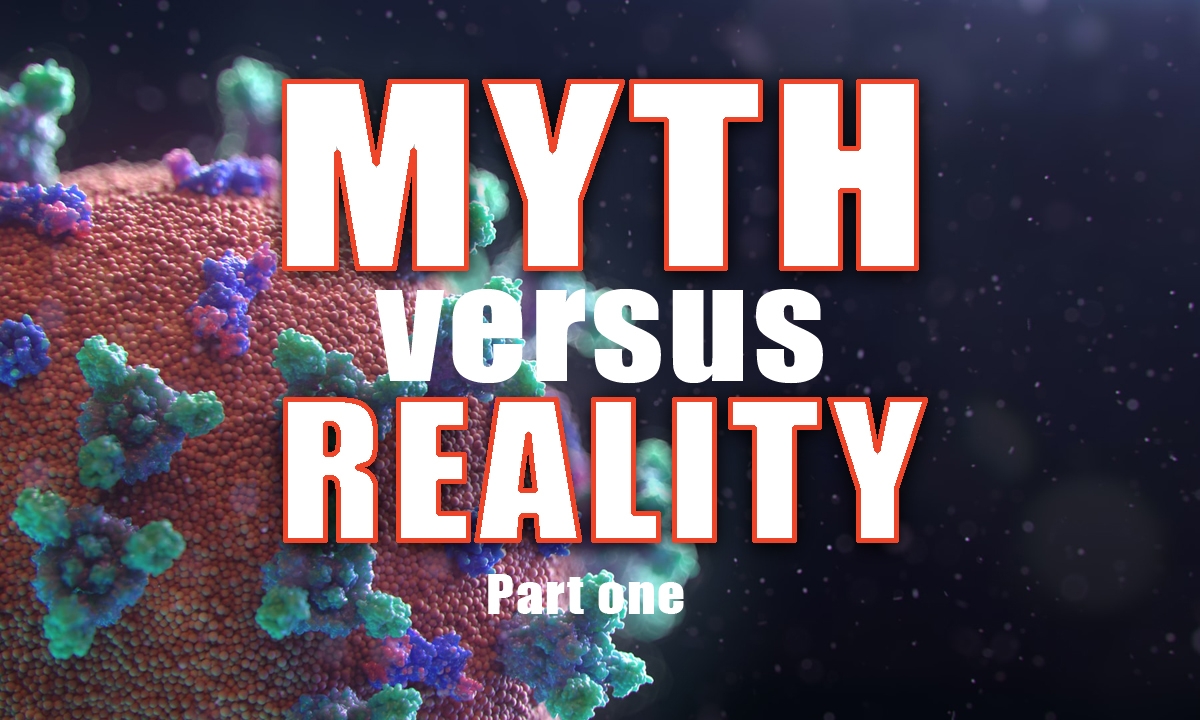
8 myths and rumors about the COVID-19 epidemic and China
Editor’s note: As countries the world over grapple with the COVID-19 pandemic, there has been much misinformation surrounding public discourse about the origin and transmission of the COVID-19 virus. Conspiracy theories have been widely circulating on social media and in some established media to support a discredited conspiracy theory that an infectious disease laboratory in Wuhan, China was the source of the pandemic. The motives behind these actions are varied, some are aimed at slandering political and ideological opponents, others target specific countries, ethnicities and religions. China is often at the receiving end of this "infodemic" of misinformation.
The following are eight of the most common rumors (part two will feature an additional eight) about the COVID-19 epidemic related to China, recently compiled and published by the Chinese embassy in Germany. All these rumors were debunked one by one based on scientific knowledge and facts, with hope to make public discourse around the topic more informed, honest, and truthful. The original version was published in Chinese and German. Ottawa Life Magazine is the first English media outlet to publish this material in Canada and did some minor editing and updated some of the information before publishing.
Rumor 1:
The COVID-19 virus is engineered at a Chinese laboratory
Fact: All evidence points to that SARS-CoV-2 has originated in nature.
The SARS-CoV-2 is a new type of coronavirus, which contains a family of viruses that can cause illness in animals and humans.
The World Health Organization noted that all available evidence suggests that the virus has an animal origin and is not manipulated or constructed in a lab or somewhere else. The possible animal source of COVID-19 has not yet been confirmed, and there are only speculations that it is possibly related to bat and pangolin.
Christian Drosten, the top virologist at Berlin's Charite hospital, and 26 other renowned scientists published a statement on the journal Lancet in February refuting the conspiracy theory that the virus is artificially made.
Kristian Andersen, an associate professor of immunology and microbiology at the Scripps Research Institute in Sweden, and other researchers published a paper on the origin of the virus in Nature Medicine in mid-March. The paper pointed out that SARS-CoV-2 is not a laboratory construct or a purposefully manipulated virus.
In an interview with Faces of Peace, Gunnar Jeremias, professor at the University of Hamburg in Germany, also refuted such conspiracy theory and said even the best laboratory in the world could not create this virus out of thin air.
Rumor 2:
The SARS-CoV-2 was released as the result of lab accident at the Wuhan Institute of Virology.
Fact: The Wuhan Institute of Virology has nothing to do with the virus' origin.
Established in 1956, the institute is the top virology research agency in China and home to Asia's highest-level biosafety lab. The institute's P4 biosecurity lab can handle the deadliest pathogens in the world. The laboratory is about 30 kilometers away from the center of Wuhan. It is impossible for the virus to leak from such a high-security laboratory, said Yuan Zhiming, a researcher at Wuhan Institute of Virology, in an interview with CGTN on April 18. He said there is no way the virus could have originated from the institute. Before accepting the first batch of test samples of COVID-19 patients on Dec 30, the institute's labs did not have the novel coronavirus. As of now, no one in the institute has contracted COVID-19. It is understandable that people would have speculation about the institute, he said. But if some people try to deliberately mislead the public, their behavior is repugnant. Click the link below to watch the interview.
EcoHealth Alliance is a non-profit organization based in New York. The chairman of the alliance, Peter Daszak, is responsible for studying emerging infectious diseases worldwide and has been cooperating with the Wuhan Institute of Virology for 15 years. In an interview with the American news website Democracy Now on April 16, Dashyak said that the claim that the novel coronavirus escaped from the laboratory was pure nonsense. There is no virus cultivation related to the new coronavirus in the laboratory of the Wuhan Institute of Virology, therefore the so-called laboratory leak is impossible.
American journalists Max Blumenthal and Ajit Singh wrote a report on the Grayzone on April 20 that the conspiracy theory about the virus escaping from China's Wuhan Institute of Virology is Trump administration's weapon of false information. It recalls the successful disinformation campaign launched by neoconservatives in the George W. Bush administration about Iraq having weapons of mass destruction. Although such weapons of mass destruction were never found, the US used them as excuses to invade Iraq, nonetheless.
Rumor 3:
The novel coronavirus is a Chinese virus because it came from Wuhan.
Fact: The official name for the virus is SARS-CoV-2. Wuhan is where the COVID-19 case was first reported, but it is not necessary the place where the virus originates.
In December 2019, Wuhan reported the first COVID-19 case, which was then called pneumonia of unknown cause. But scientists so far do not know the exact origin of the virus. Historically speaking, a place where a virus was first reported is often not where it had originated. For example, cases of HIV infection were initially reported in the United States, but its origin was most likely in West Africa. The Marburg virus was first discovered in Marburg, Hesse, Germany, but it was most likely originated in Uganda.
In order to avoid stigmatization, the WHO issued recommendations on the naming of human infectious diseases and pathogens in 2015, discouraging the use of regions, countries, individuals and animals in the naming. The novel coronavirus was officially named SARS-CoV-2 on Feb 11.
Renowned scientific journal Nature published an editorial on April 7, saying it is irresponsible and stigmatizing to associate COVID-19 with specific locations.
In fact, the COVID-19 pandemic has exacerbated racism and discrimination, especially against the Chinese and Asian people. The number of assaults toward Asian people in Germany is rising as a result.
Rumor 4:
As early as mid-November, China has known about the COVID-19 outbreak but withheld the information for 45 days.
Fact: Chinese authorities first received a report of the pneumonia case of unknown cause on Dec 27 and released its first outbreak notice on Dec 31,2020
On Dec 27, 2019, Zhang Jixian, director of the Department of Respiratory Medicine at the Hubei Provincial Hospital of Integrated Chinese and Western Medicine, reported three pneumonia cases of unknown cause to the Center for Disease Control and Prevention at Jianghan district in Wuhan. This was the first time that Chinese authorities obtained information about the disease. Zhang shared the reporting process at a recent interview.
Based on the epidemiological investigation of nucleic acid testing, a team of Chinese scientists conducted a retrospective study on the first batch of COVID-19 patients in Wuhan in December 2019. The research results were published in the authoritative medical journal the Lancet on Jan 24.
After three days of epidemiological investigation, the Wuhan Municipal Health Commission released a briefing on its website about the pneumonia with unknown cause in the city on Dec 31, confirming 27 cases and telling the public not to go to enclosed public spaces or hold gatherings. It suggested wearing face masks when going out.
Winter is the season of cold, flu and pneumonia, and COVID-19 is a new type of infectious disease with symptoms like the flu. Wuhan has 11 million residents, so it is not easy to quickly detect and diagnose patients. The WHO Director-General Tedros Adhanom Ghebreyesus and chief scientist Soumya Swaminathan wrote in a paper at the Lancet, praising Chinese doctors and health departments for their rapid discovery of the new coronavirus during the flu season.
Rumor 5:
China has withheld key information about the epidemic, which has led to a worldwide pandemic.
Fact: China has notified the world as early as possible, and resorted to the strictest epidemic control measures, which gave at least six weeks for other countries to get prepared for the outbreak.
China has notified the WHO at an early stage.
1. On Dec 31, the WHO China Office was informed of pneumonia cases of unknown cause detected in Wuhan.
2. Starting Jan 3, China began to share epidemic data with the WHO, Hong Kong and Macao Special Administrative Regions, and other countries including the United States.
3. On Jan 8, the National Health Commission expert panel made an initial judgement that the novel coronavirus caused the epidemic.
4. On Jan 12, China submitted to the WHO the genome sequence of the novel coronavirus, which was published by the Global Initiative on Sharing All Influenza Data and shared globally.
5. On Jan 16, China optimized the PCR Diagnostic Reagent
6. On Jan 20, the National Health Commission notified that the novel coronavirus could pass among humans, based on clinical evidence.
The timeline was confirmed by the WHO on its website.
The subtext to accuse China for withholding information is that China had known the virus is dangerous and didn't want to be honest about it, which is not true. For a completely new virus, there was limited scientific evidence indicating the pathogen could lead to a pandemic.
Moreover, when the virus was later confirmed to be transmissible among humans and that it was potentially more dangerous than the seasonal flu, China adopted the strictest and most comprehensive control measures, including locking down the city of Wuhan on Jan 23, and restricting movement of the entire 60 million residents in Hubei province two days later. A latest article published on Science said the travel quarantine of Wuhan had a marked effect on the international scale, where case importations were reduced by nearly 80 per cent until mid-February.
When Wuhan was placed on lockdown, 571 domestic infections on the Chinese mainland and 9 total overseas cases had been reported, none of them in Europe, according to the National Health Commission. When China suspended all outbound tourist travel on Jan 27, the Chinese mainland had 2,744 infections, China's Hong Kong, Macao and Taiwan had 17 infections, and the rest of the world had reported 33, three in Europe. By Feb 23 – a month after Wuhan was put on lockdown – the global tally was 78,811, of which only 2.2 per cent were outside China. Between this period, only a handful of countries, save for East Asian nations, had adopted any form of effective prevention measures.
The Trump administration had been downplaying the severity and danger of COVID-19 until early March. The surge of confirmed cases in China within a month and half, as well as the unprecedented lockdown of the Wuhan city, could not have sent a clearer and louder warning. The New York Times has published an investigative piece on April 11 on this topic.
Rumor 6:
China attempted to suppress information about the epidemic by arresting whistle-blowing doctors.
Fact: No doctors have been arrested for whistleblowing. In contrary, doctors who reported the disease to their higher-ups were rewarded by central authorities.
On Dec 30, Wuhan ophthalmologist Li Wenliang shared a lung CT scan and other medical records in a private WeChat (a popular instant-messaging app in China) group with his medical school classmates. Li claimed seven people were confirmed to have contracted SARS and reminded the group members not to further spread such information.
However, the screenshots were widely shared on the Internet. On Jan 3, the Wuhan police reprimanded Li and asked him not to spread SARS-related rumors as they might cause social panic. Li was not fined or arrested and returned to his post with no further punishment. In mid-January, Li got infected while treating a COVID-19 patient and tested positive for COVID-19 on Jan 31. He died on Feb 7 after arduous rescue efforts. On the same day, the National Health Commission sent condolences for his death.
Doctor Li is not a "whistle-blower" in the sense defined by western media. He had never reported the situation to health authorities, nor openly warned the public. As a matter of fact, on Dec 27, Zhang Jixian, another doctor in Wuhan, already notified local authorities about an unknown pneumonia, and the government had been investigating the situation for three days before Li made his claims in WeChat. Zhang was later rewarded for her actions.
On Feb 7, the National Supervisory Commission sent a delegation to Wuhan to investigate issues related to Li's death. The findings were published on March 19, saying the police probe into the matter was carried out in accordance with the law, as the Law on the Prevention and Treatment of Infectious Diseases has strict requirements on the reporting, verification and release of epidemic information. But the action taken by the police to reprimand Li was inappropriate, and the law enforcement procedure was also not up to standards. On the same day, the Wuhan police revoked the reprimand letter to Li, and sincerely apologized to his family.
Li was a good doctor, and a member of the Communist Party of China. On April 2, the Chinese government deemed him a martyr. However, the United States took advantage of his unfortunate death, and painted him as an anti-communist fighter, which is baseless.
The Independent Media Institute has investigated the matter.
Rumor 7:
China has whitewashed its COVID-19 confirmed and death cases.
Fact: China has always been transparent on the numbers of confirmed and deceased cases and has fulfilled its duty of notifying the public.
By April 20, Wuhan reported 50,333 confirmed infections and 3,869 deaths, with a crude morality rate of 7.69 per cent, higher than the current global average.
China's relatively small numbers of confirmed and death cases were due to the nation's taking the strictest, most comprehensive and timely quarantine measures, including city-wide lockdown. These measures have reduced over 700,000 infections in China, according to an article published by the journal Science on March 30.
Since the outbreak, the Chinese central government has dispatched more than 42,000 medical workers to Hubei province, built two designated hospitals with a total of more than 2,000 beds for severe patients, as well as 16 mobile cabin hospitals hosting around 13,000 beds for mild cases in Wuhan. All suspected patients and those in close contact with confirmed patients have been quarantined in designated areas. These measures have cut off the chain of transmission and stopped the epidemic from spreading. German newspaper Handelsblatt has praised the measures in an editorial.
On April 17, the Wuhan government revised the city's accumulated death toll of COVID-19 from 2,579 to 3,869, and the infection case from 50,008 to 50,333. The amendment is in line with the nation's relevant laws and regulations. It is also an international common practice to verify and revise statistics after the epidemic is under control. China released the updated numbers accurately and timely and was praised by the WHO for leaving no case undocumented.
Rumor 8:
China has manipulated the WHO to escape from global criticism.
Fact: The WHO is an independent international organization with 194 members, and it is impossible for any single nation to bend it to its will.
Of the 21-strong leadership team at the WHO headquarters, 11 of them are from the United States, the European Union and Canada, and only one is from China. Ren Minghui has served as WHO's Assistant Director-General for HIV/AIDS, Tuberculosis, Malaria and Neglected Tropical Diseases since January 2016 and is continuing this work under the new title of Assistant Director-General for Communicable Diseases.
The US was the biggest financial contributor to the WHO before it decided to cut off the funding recently. China ranks only the sixth in terms of funding, with voluntary donations considered.
The WHO consists of senior experts from the medical and public health sector, who are seasoned veterans in the fight against contagious diseases. Their work relies on science, evidence and professional knowledge.
In addition to China, almost all WHO members have clearly stated their support for the work done by WHO Director-General Tedros Adhanom Ghebreyesus. It is baseless to claim he was elected due to China's help.
Photo: Fusion Medical Animation ,Unsplash











